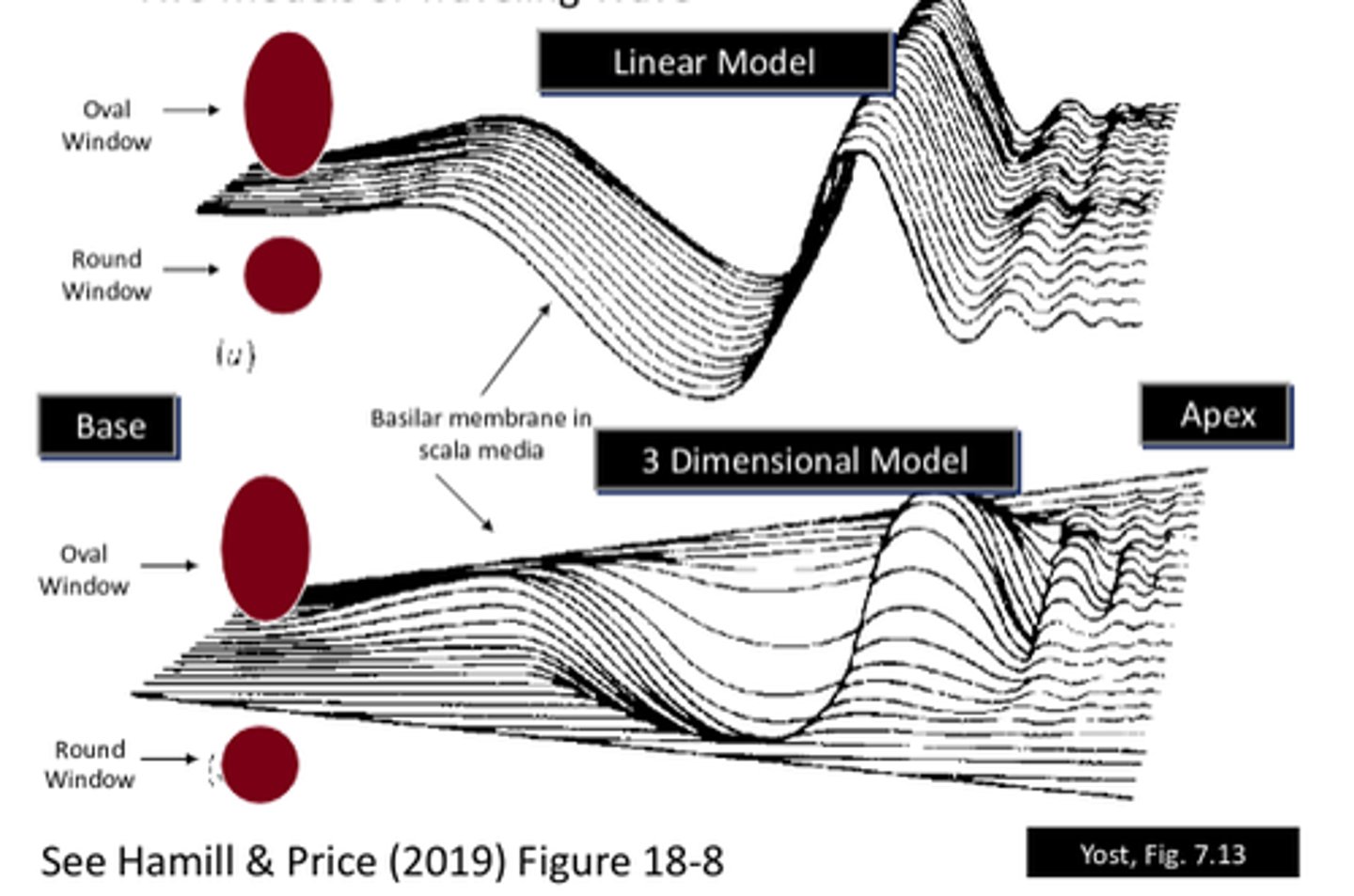Hearing Science: Cochlear Physiology
1/25
There's no tags or description
Looks like no tags are added yet.
Name | Mastery | Learn | Test | Matching | Spaced |
|---|
No study sessions yet.
26 Terms
What are the three modes of cochlear physiology?
hydraulic
mechanical
chemo-electrical
What is the first step of the cochlea?
begins with mechanical stimulation
-stapedial footplate at oval window
What is the second step of the cochlea?
mechanical energy transduced into hydraulic motion of perilymph
-made possible by the polarization effect
What is the third step of the cochlea?
hydraulic action in bony labyrinth mechanically causes motion of endolymoh
-stimulates the Corti's Organ
-soft tissue displaced by wave motion
What is the fourth step of the cochlea?
motion of sensory cells creates chemo-electrical response
Georg von Békésy
Theory of the Traveling Wave
-first to study the function of the auditory organ experimentally
What four observations was Von Békésy's Theory of the Traveling Wave based on?
1. Deflection of the basilar membrane
2. Height of displacement/deflection
3. Point of maximal displacement is frequency specific
4. Frequency specificity is a passive feature
Deflection of the Basilar Membrane
as the stapes stimulates the perilymph at the oval window, the BM pushes downward by pressure of the hydraulic wave
-hydraulic motion travels from base to apex
-one-way direction of the traveling wave
Height of Displacement/Deflection
height of displacement gradually increases as the wave travels to the apex. This is due to the close match between the frequency of the wave's vibrations and the resonance characteristics of the basilar membrane
-the traveling wave reaches maximum amplitude, then quickly diminishes
Point of Maximal Displacement is Frequency Specific
it occurs at the place where the frequency of the wave matches the resonant characteristics of the basilar membrane (BM)
-recall that the BM gets wider and loses stiffness from base to apex. BM "tuned" to vibrate best at specific frequencies.
-highest frequencies at basal end
-lowest frequencies at apical end
-basilar membrane acting as series of passband filters
Frequency Specificity is a Passive Feature
due to gradient change in stiffness of the basilar membrane from base to apex
The Traveling Wave in the Cochlea
mechanical vibrations of the ossicular chain and transformed into hydromechanical energy in the cochlea
-"hydro" = the fluid in the cochlea
-"mechanical" = the motion of the structures within the cochlea
Is the maximal displacement of the basilar membrane frequency specific?
yes
When are low frequency sounds detected?
later than high frequency sounds
What is the function of the cochlea?
when the stapes moves back and forth, all locations along the basilar membrane receive the same vibrational input at the same time due to the incompressible nature of the fluid-filled cavity
Why does the traveling wave in the cochlea always move from base to apex?
it is in response to an applied force, the narrower and stiffer base will always vibrate before the wider and less stiff apex
-there is less inertia (less mass) to overcome at the base
What happens to the amplitude (amount of displacement) of the traveling wave from the base to the apex?
the traveling wave is relatively low at the base and then grows to its peak at the stimulus frequency location, then decays rapidly

What happens when the stereocilia bend towards the tallest row (away from the modiolus)?
triggers the excitatory phase of the hair cells
When does the excitatory phase of the hair cells occur?
when the BM moves towards the scala vestibuli
What happens to the hydromechanical energy?
it is transduced into neural energy as the signal moves into the afferent nerve fibers
Two Models of the Traveling Wave
linear and 3D model

Linear Model of the Traveling Wave
direction: from base to apex
-linear model shows the direction and amplitude of the traveling wave
-the amplitude is the distance between the following trough and the crest of the wave
-signal is processed at a place where the wave reaches the peak amplitude
-the part of the BM with resonant characteristics consistent with the frequency content of the sound input
What did Von Bekesy do?
demonstrated that the place of maximum displacement is frequency dependent
If the sound has a high frequency content...
the wave will not travel very far
If the sound has a low frequency content...
it will travel further
Why does the traveling wave not go beyond the location of "best resonance" (for moderate level sounds)?
due to the increasing resistance caused by an increasing impedence mismatch